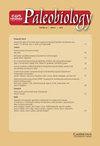Convergence and constraint in the cranial evolution of mosasaurid reptiles and early cetaceans
IF 2.6
2区 地球科学
Q2 BIODIVERSITY CONSERVATION
引用次数: 6
Abstract
Abstract. The repeated return of tetrapods to aquatic life provides some of the best-known examples of convergent evolution. One comparison that has received relatively little focus is that of mosasaurids (a group of Late Cretaceous squamates) and archaic cetaceans (the ancestors of modern whales and dolphins), both of which show high levels of craniodental disparity, similar initial trends in locomotory evolution, and global distributions. Here we investigate convergence in skull ecomorphology during the initial aquatic radiations of these groups. A series of functionally informative ratios were calculated from 38 species, with ordination techniques used to reconstruct patterns of functional ecomorphospace occupation. The earliest fully aquatic members of each clade occupied different regions of ecomorphospace, with basilosaurids and early russellosaurines exhibiting marked differences in cranial functional morphology. Subsequent ecomorphological trajectories notably diverge: mosasaurids radiated across ecomorphospace with no clear pattern and numerous reversals, whereas cetaceans notably evolved toward shallower, more elongated snouts, perhaps as an adaptation for capturing smaller prey. Incomplete convergence between the two groups is present among megapredatory and longirostrine forms, suggesting stronger selection on cranial function in these two ecomorphologies. Our study highlights both the similarities and divergences in craniodental evolutionary trajectories between archaic cetaceans and mosasaurids, with convergences transcending their deeply divergent phylogenetic affinities.沧龙爬行类和早期鲸目动物颅骨进化的趋同与限制
摘要四足动物反复回归水生生物提供了一些最著名的趋同进化例子。一个相对较少受到关注的比较是摩萨目(晚白垩世的一组鳞片动物)和古代鲸目动物(现代鲸鱼和海豚的祖先),这两种动物都表现出高度的颅骨差异、运动进化的相似初始趋势和全球分布。在这里,我们研究了这些群体在最初的水生辐射过程中头骨形态的趋同。从38个物种中计算了一系列功能信息率,并使用排序技术重建了功能生态形态空间占用模式。每个分支中最早的完全水生成员占据了不同的生态形态空间区域,巴西龙类和早期罗素龙类在头骨功能形态上表现出显著差异。随后的生态形态轨迹明显不同:mosasaurids在生态形态空间中辐射,没有明确的模式和多次反转,而鲸目动物则明显向更浅、更细长的鼻子进化,这可能是为了适应捕捉较小的猎物。两组之间的不完全融合存在于大型掠食性和长喙类动物中,这表明在这两种生态形态中,对颅骨功能的选择更强。我们的研究强调了古代鲸目动物和摩萨目动物在颅牙进化轨迹上的相似性和差异性,它们的趋同超越了它们截然不同的系统发育亲缘关系。
本文章由计算机程序翻译,如有差异,请以英文原文为准。
求助全文
约1分钟内获得全文
求助全文
来源期刊

Paleobiology
地学-古生物学
CiteScore
5.30
自引率
3.70%
发文量
38
审稿时长
>12 weeks
期刊介绍:
Paleobiology publishes original contributions of any length (but normally 10-50 manuscript pages) dealing with any aspect of biological paleontology. Emphasis is placed on biological or paleobiological processes and patterns, including macroevolution, extinction, diversification, speciation, functional morphology, bio-geography, phylogeny, paleoecology, molecular paleontology, taphonomy, natural selection and patterns of variation, abundance, and distribution in space and time, among others. Taxonomic papers are welcome if they have significant and broad applications. Papers concerning research on recent organisms and systems are appropriate if they are of particular interest to paleontologists. Papers should typically interest readers from more than one specialty. Proposals for symposium volumes should be discussed in advance with the editors.
 求助内容:
求助内容: 应助结果提醒方式:
应助结果提醒方式:


